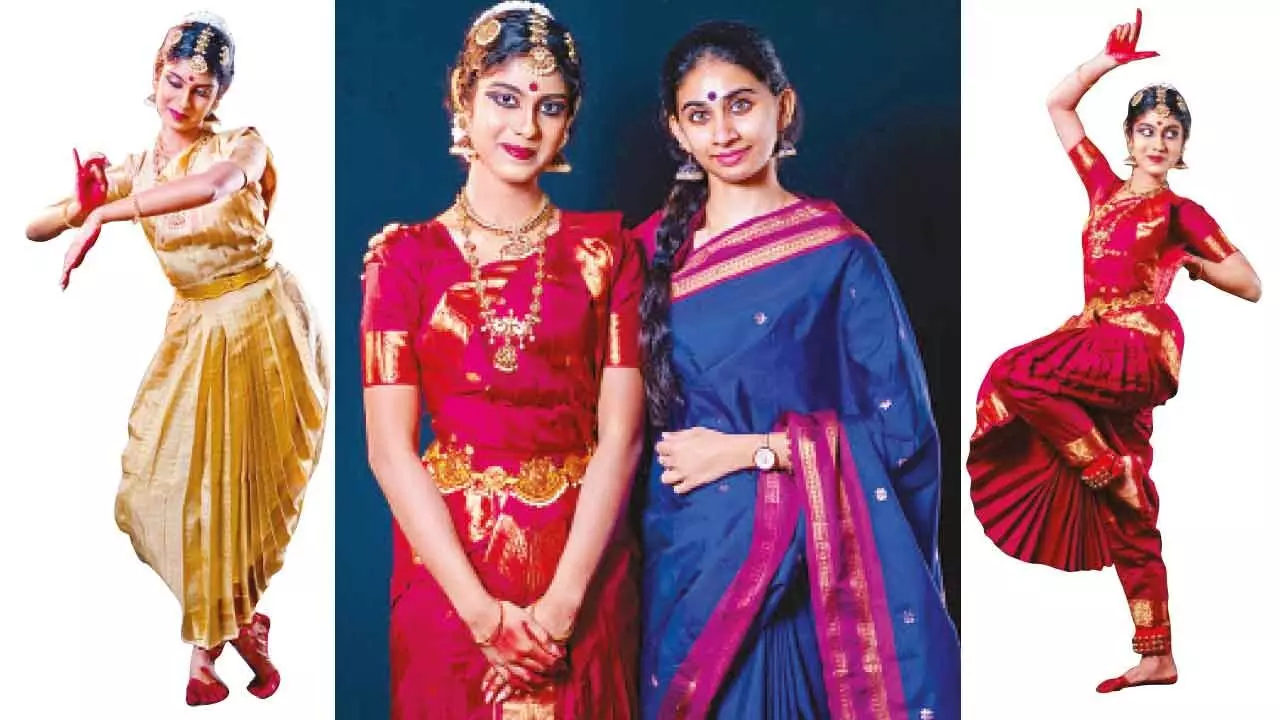The Global Peace Auditorium in Gachibowli came alive as Shubha Kambhampati took center stage for her Bharatanatyam Arangetram under the guidance of Guru Sahitya Ramkumar. A celebration of tradition, talent, and tutelage, the evening marked a significant milestone for both dancer and Guru The debut Bharatanatyam Arangetram from Sahityakalpa School of Arts was a treat to watch. Shubha Kambhampati was the perfect student for her young Guru, Sahitya Ramkumar, who was presenting the first Arangetram from her school.
Sahitya is well known in Hyderabad for her solo productions — Margam and Iti Kalyani. Donning the role of Shubha’s Acharya was a natural fit for her, and she elicited a masterly performance. Shubha shows all the promise of a budding talent.

The vast stage at the Global Peace Auditorium, Gachibowli, on Saturday was gaily adorned with festoons of flowers heralding the occasion. These floral decorations served as an appropriate garnish for the feast that was to follow. The impeccable lineage of Kalakshetra was on display, as Sahitya’s teacher is the renowned Guru Pasumarthy Ramalinga Sastry, who in turn was a student of the legendary Rukmini Devi Arundale.
Shubha has completed her high schooling at Rishi Valley, where she studied Physics, Mathematics, Fine Art, and Computer Science. She holds a Diploma in Carnatic Music and is an avid enthusiast of nature and outdoor activities. Her love for trekking and marathons has helped her develop stamina and a fine sense of balance, which was evident throughout the program.
Shubha began learning dance as a child under Dr. Padmaja Karanam, who laid a solid foundation and encouraged her to persist. She is now honing her skills and engaging more deeply with her chosen art form under her current Guru Sahitya’s tutelage.
The lights dimmed and then brightened, casting a halo around the dancer as Shubha made her first appearance on stage, dressed in a gossamer light confection of gold and cream aharya from “Tarikita,” pleasing to the eye. Make-up by Ramaswamy dazzled. The Ganesh Stuti in Hamsadhwani by Balamuralikrishna was a melodious piece that opened the recital auspiciously.
Shubha was poised and composed as she performed the pallavi or refrain “Pari Pari Nee Padame” — expressing the mind’s repeated adoration of the sacred feet of Vinayaka, who is exceedingly compassionate. Her fingers, forming the appropriate mudras, were enunciated effectively, and her gestures were emphatic. Ganesha was portrayed as being assured that his devotee, who eternally belongs to him, would not trouble him with boons.
His blessed elephant-faced visage would never be abandoned. The flute and drums were delicately mimed by Shubha as Ganapati danced, accompanied by the nectar-like music of these instruments. This worship, beginning with his adoration, was sure to bring happiness.
A Saraswathi Jatiswaram followed, offering scope for intricate interplay of rhythmic patterns and melodic swaras. This purely nritta piece showcased the dancer’s command over rhythm, form, and grace. Serene and deep like the raga’s nature — blending joy and quiet melancholy — it created a soft yet profound aura that led to a sense of blissful fulfillment as the final strains wafted through the hall.
The Swarajati in Husseini was a paean of shringara-embedded bhakti. It portrayed the emotions of love (bhavas) that the nayika or heroine feels and wishes to express toward her nayaka or hero. Lord Achyutha is the subject of the lamentations of a disregarded nayika.
The long swarajati was ably carried out with no flagging of energy, earning applause for each flourish that concluded the jathis, which were a constant interplay of inventive percussion by the Mridangam. A costume change followed — the maroon shade made the dancer resemble a glowing amethyst as she pirouetted in adavu patterns in the majestic “Akhilandeshwari” of Muthuswami Dikshitar, set in Dwijawanti. Shubha shone as she rendered the glorious visage of the dark-complexioned Goddess with long tresses, smilingly bestowing boons — the conferrer of supreme knowledge.
The fast-paced Dhanashree Thillana depicted the sound of anklets and concluded with praise for Lord Padmanabha, as Shubha eloquently enacted the characteristic recumbent pose of the deity. Geetopadesam followed, showcasing some excerpts in shlokam form — the essence of sattvika abhinaya — as Arjuna, troubled by his predicament of fighting his own kin, is reassured and rejuvenated by Lord Krishna’s discourse and the Vishwaroopa Darshana climax, a riot of light effects created by Surabhi Kishore. About the only criticism one might offer is that Sahitya, as a tribute to her own Guru, chose a rather taxing series of his most cherished, complex, and elaborate pieces — which placed quite a burden on Shubha’s young shoulders.
Nevertheless, she carried it out to the best of her considerable ability. Rohith Bhat from Bengaluru was an exceptionally amazing vocalist. Chandrakanth matched brilliantly in his percussive talents, pairing seamlessly with Sahitya’s lucid nattuvangam in sparkling dialogue.
Sai Kolanka’s Violin teased out the most exquisite strains of melody. Venkateshwarlu’s flute was enchantingly scintillating, and Sridharacharya’s special effects were magically vivid, as always! SNA Awardee Shri Pasumarthy Ramalinga Sastry and Padmashri Dr. Ananda Shankar Jayant presided as the chief guests.
.











_updates.jpg)




